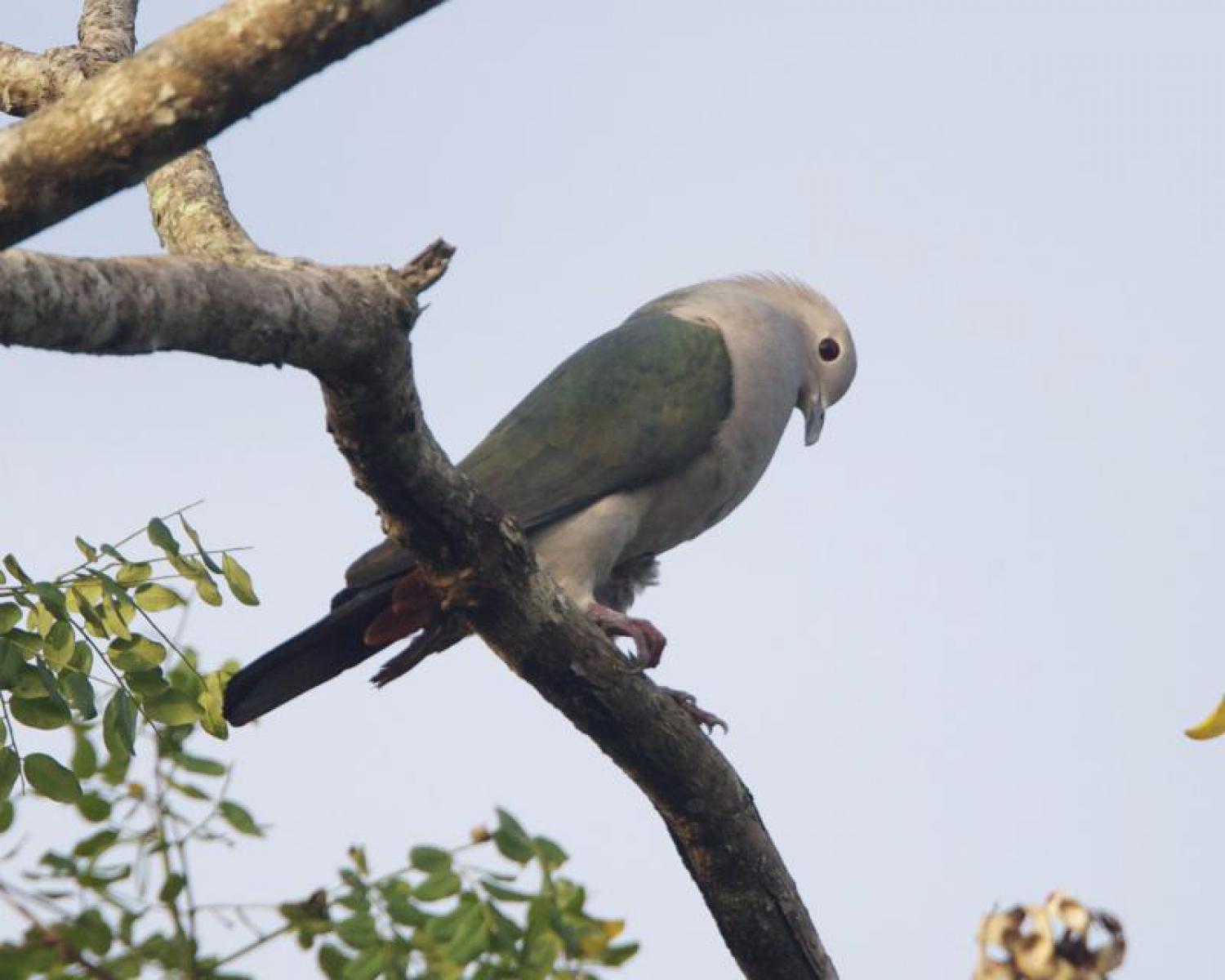Species of Thailand
Green imperial pigeon
Ducula aenea
Carolus Linnaeus, 1766
In Thai: นกลุมพูเขียว
The green imperial pigeon (Ducula aenea) is a large forest pigeon. The large range extends from southern India and Sri Lanka eastwards to southern China, Indonesia and the Philippines.
Taxonomy
In 1760 the French zoologist Mathurin Jacques Brisson included a description of the green imperial pigeon in his six volume Ornithologie. He used the French name Le pigeon ramier des Moluques and the Latin Palumbus moluccensis. Although Brisson coined Latin names, these do not conform to the binomial system and are not recognised by the International Commission on Zoological Nomenclature. When in 1766 the Swedish naturalist Carl Linnaeus updated his Systema Naturae for the twelfth edition, he added 240 species that had been previously described by Brisson. One of these was the green imperial pigeon which he placed with all the other pigeons in the genus Columba. Linnaeus included a brief description, coined the binomial name Columba aenea and cited Brisson's work. Brisson believed his specimen had come from the Maluku Islands but the species does not occur there and in 1918 the type locality was designated as the island of Flores in Indonesia. The specific name aenea is from the Latin aeneus meaning "of a bronze colour" or "coppery". This species is now placed in the genus Ducula that was introduced by the English naturalist Brian Houghton Hodgson in 1836.
Twelve subspecies are recognised:
- D. a. sylvatica (Tickell, 1833) – north India and Nepal to south China to Thailand, and Indochina
- D. a. pusilla (Blyth, 1849) – south India, Sri Lanka
- D. a. andamanica Abdulali, 1964 – Andaman Islands
- D. a. consobrina (Salvadori, 1887) – islands of West Sumatra except Enggano Island
- D. a. oenothorax (Salvadori, 1892) – Enggano Island
- D. a. polia (Oberholser, 1917) – Malay Peninsula to Greater and Lesser Sunda Islands
- D. a. palawanensis (Blasius, W, 1888) Banggi Island (north Borneo) to Palawan and nearby islands (southwest Philippines)
- D. a. fugaensis (Hachisuka, 1930) – north Philippines (Calayan, Camiguin and Fuga Island)
- D. a. nuchalis (Cabanis, 1882) – north Luzon (north Philippines)
- D. a. aenea (Linnaeus, 1766) – Philippines (other than northern Luzon and Palawan)
- D. a. intermedia (Meyer, AB & Wiglesworth, 1894) – Talaud Islands and Sangihe Islands
- D. a. paulina Bonaparte, 1854 – Sulawesi, Togian, Banggai and Sula Islands
The subspecies D. a. oenothorax is sometimes treated as a distinct species, the Enggano imperial pigeon (Ducula oenothorax). The Nicobar imperial pigeon (Ducula nicobarica) was formerly treated as conspecific.
Description
The green imperial pigeon is a large, plump pigeon, 45 cm in length. Its back, wings and tail are metallic green. The head and underparts are white, apart from maroon undertail coverts. Sexes are similar. The bird's call is deep and resonant, and is often the first indication of the presence of this treetop species.
Distribution and habitat
This is a forest species which is a widespread resident breeding bird in tropical southern Asia from India east to Indonesia. It has several subspecies, including the distinctive Celebes form, chestnut-naped imperial pigeon (Ducula aenea paulina).
Behaviour and ecology
This is an arboreal dove, feeding on plant material in the tree canopy. Its flight is fast and direct, with the regular beats and an occasional sharp flick of the wings which are characteristic of pigeons in general. It builds a stick nest in a tree and lays a single white egg. The birds are not very gregarious, but will form small flocks.
This article uses material from Wikipedia released under the Creative Commons Attribution-Share-Alike Licence 3.0. Eventual photos shown in this page may or may not be from Wikipedia, please see the license details for photos in photo by-lines.
Category / Seasonal Status
BCST Category: Recorded in an apparently wild state within the last 50 years
BCST Seasonal status: Resident or presumed resident
Scientific classification
- Kingdom
- Animalia
- Phylum
- Chordata
- Class
- Aves
- Order
- Columbiformes
- Family
- Columbidae
- Genus
- Ducula
- Species
- Ducula aenea
Common names
- English: Green imperial pigeon
- Thai: นกลุมพูเขียว
Synonyms
- Ducula aeneus, Carolus Linnaeus (1766)
- Columba aenea, Carolus Linnaeus (1766)
- Carpophaga aenothorax
Photos
Please help us review the bird photos if wrong ones are used. We can be reached via our contact us page.
Range Map

- Doi Pha Hom Pok National Park
- Doi Suthep - Pui National Park
- Hala-Bala Wildlife Sanctuary
- Huai Kha Khaeng Wildlife Sanctuary
- Khao Ang Rue Nai Wildlife Sanctuary
- Khao Soi Dao Wildlife Sanctuary
- Khao Sok National Park
- Khao Yai National Park
- Khura Buri District, Phang Nga
- Ko Chang National Park
- Ko Lanta National Park
- Ko Ngai
- Ko Tao
- Mae Wong National Park
- Mueang Surat Thani District, Surat Thani
- Non Din Daeng District, Buriram
- Pang Sida National Park
- Phi Phi Islands
- Phu Chong Na Yoi National Park
- Similan Islands
- Sirinat National Park
- Surin Islands
- Tarutao National Marine Park
- Than Sadet - Koh Pha-Ngan National Park
- Yod Dom Wildlife Sanctuary



